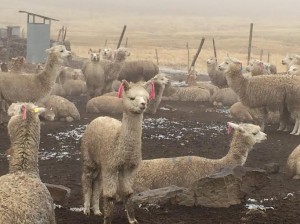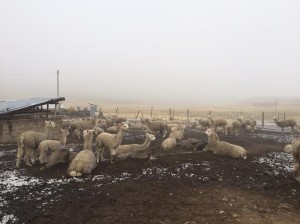Although I grew up in countryside, in the northern of Romania, and I was familiar with the animals in the area such as horses, cows, and sheep, just to mention a few, I was not familiar with alpaca. However, when I arrived in the south of Peru, the province of Ayacucho, I observed alpacas everywhere: by the side of the road, on the hills, and on the mountains. My mission in Peru is to learn about the alpaca wool, its industry, and to implement an income generation project for families who have been victims of the military conflict. Whether I like alpacas or not, I have to learn about them.
Peru is the homeland for most of the alpacas in the world. It is estimated that in Peru are 5,200.000 alpacas, which makes 89% of the alpacas in the world, and it exports six tones of alpaca fiber wool annually. 90% of this production is exported internationally. The higher quality and expensive wool is the alpaca baby.
Alpacas grow at higher altitudes. They can be found at 3,500 meters above the sea level, and even higher, at 4,600 meters. Alpacas are fed with the natural pasture, which they found on the hills, mountains, and valleys. In Peru, people consider the meat of alpaca one of the best because it has zero cholesterol, and this is because of the altitude where these animals grow, and the food they consume. Alpacheros, people who grow alpacas, grow them for meat and for wool. An alpaca has a life expectancy between 20 and 25 years, and it gives birth every year.
Although the alpaca wool is highly valued, the alpacheros sell the wool at very low prices because they do not add any value to it. In other words, they shear the alpacas, and sell the wool as a raw material. Additionally, they do not separate the fine fiber from the thick, and do not spin or weave it. They spin and weave occasionally for personal use.
The shearing time happens once a year, in April for young alpacas, and in November for the rest of alpacas. During these two periods, a buyer travels from community to community and buys the wool in large quantities at lower prices. If the alpacheros do not sell the wool at the price offered, another buyer is not coming again to buy the wool. This means that the buyer has monopoly over the wool in these communities, and the alpacheros are forced to sell the wool at the price offered.
The alpacheros say that recently the prices of the wool dropped from 9-12 soles to 6-8 soles per pound. On average, an alpaca produces between 4 to 5 pounds of wool annually. The colors of organic alpaca wool come in six varieties: white, light cream, maroon, dark gray, and black. The highest price that a person is making when selling the wool to an intermediary from one alpaca is 60 soles, ($18.30). This means that alpacheros need to feed them, give them treatment against various diseases, protect them from being killed and eaten by wild animals, and finally they make 60 soles in the wool if the buyer offers the highest price, which is 12 soles per pound, but usually this does not happen.
The just price for one kilo of alpaca baby turned into yarn in Peru is between 120 and 136 soles ($36.60 and $41.44). This means that an alpaca can bring a profit of approximately 300 soles ($91.42) in the wool annually if the wool is processed.
The alpacheros need to process the wool in order to sell it at higher prices, which will allow them to improve the quality of their lives and the lives of future generations. To do this, building a center to process the wool, and turning it into yarn is a necessity. If the wool is not processed, the alpacheros will continue to sell the wool to the intermediaries at lower prices. Thus, we need to support and capacitate the alpacheros who have been victims of the military conflict.
Posted By Daniel Prelipcian (Peru)
Posted Jul 13th, 2016




139 Comments
Rachael Hughen
July 15, 2016
Hi Daniel! I hope you do end up taking a liking to alpacas because there sure seem to be enough of them around! I wonder if you can take one on the plane with you when you come back in August. The research you’ve done on the wool trade so far is fascinating, I can’t believe they can only sell about twice a year to a single person. It really must force the alpacheros into a corner in terms of prices. Does it look like your main goal at this point will be getting a wool processing center set up in this region?
Daniel Prelipcian (Peru)
July 15, 2016
I would love to take one alpaca with me, and probably walking with it on the streets of Manhattan, I will be able to make a lot of money 🙂 However, I do not think that there will be a place available at business class for alpaca 🙂 🙂
Daniel Prelipcian (Peru)
July 15, 2016
Yes, that is my main goal, to help them to process the wool. If we can do this, the intermediaries will disappear. Isn’t this great? Based on my research, talking extensively with Alpacheros, and I had two meetings with the manager of Prosynergy, an NGO which capacitated some communities to process the wool in Peru, the only way to make higher profits from the wool is to process it. I wished to be a short cut, but I’m afraid that there is none.